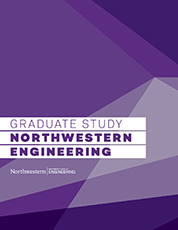Simplifying Signage for a Better Airport Experience
EDI student Clark Mitchell spent the summer interning with United Airlines to help improve the company's signage system at airports across the country.

Traveling in airports can be stressful. Clark Mitchell spent last summer trying to help ease passenger stress, at least a little bit.
Mitchell, a student in Northwestern's Master of Science in Engineering Design Innovation (EDI) program, did their summer internship with United Airlines, traveling around the country to learn how people interacted with signage in various airports.
Mitchell’s mission was clear: Simplification.
“The goal of the project was to try to make the signage system better for everyone, largely by reducing the excess signage in many airports that ends up overwhelming a lot of the people it's meant to help,” they said.
That brought the EDI program’s focus on human-centered design to the forefront.
The principle behind human-centered design is that the best way to design useful products is through empathy and intense research into what those humans say — and show — they want and need.
Beyond Chicago's O'Hare International Airport, Mitchell spent time in San Francisco, Atlanta, Washington, D.C., and both Newark Liberty International Airport in New Jersey and LaGuardia Airport in New York.
“I interviewed everyone from passengers to people in corporate offices approving and ordering signage, in addition to observing travelers across the country,” Mitchell said. “I primarily functioned as a researcher but got to move to designing the initial programs for evaluating and implementing signage in the future.”
Mitchell said one of the most valuable things to come from their internship experience was practical application of the concepts learned in the EDI program.
“I think one of the big things that I learned through this internship was how human-centered design could look within a company instead of in the academic setting,” they said. “We spend so much time learning in the classroom, and though it's great and we work with real sponsors, actually being in and working for a company is vastly different.”
The internship experience led Mitchell to have a greater appreciation for what they have been learning in the EDI program. It quickly became apparent at United that the coursework directly tied in with the practical application.
“EDI was the exact experience I needed for this internship,” they said. “Learning the planning and execution of a human-centered design project is exactly what this internship went through, so I felt completely prepared because of my experiences at Northwestern.”
The internship also provided momentum for Mitchell's remaining time in the EDI program.
“It was a big confidence boost. The internship prepared me for Thesis in the way that it was a project that I fully self-set and conducted,” Mitchell said. “The fact that I could pursue and complete this project mostly on my own was fantastic, both from my own point of view as well as for how I think about these tasks moving forward.”
The internship, coupled with their EDI program, has left Mitchell with more questions than answers about what job to pursue after graduation.
It's a problem Mitchell is perfectly happy to face.
“I'm still open in a lot of ways,” they said. “I love my time in research, and service design as a medium still fascinates me, so I feel like I have more options to consider than anything.”

